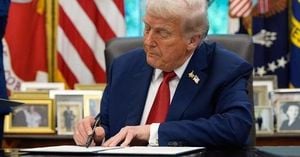On September 26, 2025, the situation in Ukraine remained as tense and complex as ever, with the country caught between the relentless advance of war and the determined efforts of its people and international allies to restore hope and stability. Recent days have seen a flurry of developments on multiple fronts—military, humanitarian, economic, and political—shaping the trajectory of a conflict that has already left deep scars across the nation.
Ukraine’s eastern regions, particularly Donetsk and Luhansk, have once again become the epicenter of intense military action. According to berawangnews.com, the Ukrainian Armed Forces have ramped up their operations, launching successful counteroffensives that have reclaimed key territories previously under heavy contest. These advances have not only lifted the spirits of Ukrainian troops but have also strengthened the country’s strategic position in a war that shows little sign of abating.
Not to be outdone, Russian forces have responded with a marked increase in aerial bombardments. Cities like Kharkiv and Zaporizhzhia have been subjected to repeated air raids, with critical infrastructure coming under direct fire. The human cost of this escalation is mounting, as civilians find themselves caught in the crossfire and vital services are disrupted. The rising civilian toll has prompted urgent calls from the international community for humanitarian intervention and adherence to the laws of war.
Amidst the chaos, the international response has remained steadfast. The United States, United Kingdom, and European Union have reaffirmed their unwavering support for Ukraine, providing military aid, intelligence sharing, and humanitarian relief. As reported by berawangnews.com, NATO leaders have pledged continued assistance, including advanced weaponry, in an effort to bolster Ukraine’s defenses. At the same time, Western governments are hammering out new rounds of sanctions targeting Russian oligarchs and key industries, aiming to tighten the economic noose around the Kremlin.
Yet, the war’s impact extends far beyond the battlefield. Ukraine’s economy, once a breadbasket for much of the world, has been battered by landmines, disrupted supply lines, and the constant threat of violence. The agricultural sector, in particular, has faced severe challenges. Nevertheless, there are glimmers of resilience: Ukrainian grain exports are slowly inching back toward pre-war levels, thanks in part to international agreements that guarantee safe passage through the Black Sea. These agreements are crucial, given the country’s dependence on agricultural exports for economic survival.
To help steady the economic ship, the Ukrainian government—backed by international financial institutions—has rolled out stabilization policies focused on rebuilding infrastructure and maintaining essential services. However, as berawangnews.com notes, the long-term outlook remains uncertain, with global food prices still volatile and the specter of further disruption ever present.
Perhaps nowhere is the war’s toll more painfully evident than in the humanitarian crisis now gripping Ukraine. Millions of people have been uprooted from their homes, either displaced internally or forced to seek refuge in neighboring countries like Poland, Romania, and Hungary. Aid agencies, including the United Nations and the International Red Cross, are working tirelessly to deliver food, shelter, and medical care. But as winter looms, the needs of displaced Ukrainians are only growing more acute. Makeshift shelters and crowded camps are ill-equipped to handle the harsh conditions, and many families face dire shortages of basic necessities.
Into this landscape of hardship steps a new initiative aimed at bolstering Ukraine’s healthcare system in one of its most embattled regions. On September 25, 2025, the King Salman Humanitarian Aid and Relief Centre (KSrelief) and the United Nations Office for Project Services (UNOPS) signed a landmark agreement to deliver over USD 5 million worth of specialized medical equipment to four hospitals in the Kharkiv Region. This project, as detailed in a joint release from KSrelief and UNOPS, is designed to expand both in-patient and out-patient capacity, providing critical support for surgery, trauma care, intensive care, diagnostics, and radiology.
Oleh Syniehubov, Head of the Kharkiv Regional Administration, underscored the urgency of the initiative, stating, “The Kharkiv Region faces serious challenges related to the ongoing full-scale invasion by Russia. Ensuring that quality medical services are available to our community members and internally displaced persons is vital under these circumstances.” He went on to thank UNOPS and KSrelief for their support, highlighting ongoing efforts to restore and improve healthcare facilities in the region.
The project marks the first collaboration between KSrelief and UNOPS in Ukraine, building on UNOPS’ global experience in procuring and delivering medical equipment. Dr. Abdullah Al Rabeeah, Supervisor General of KSrelief, praised the commitment of Ukrainian healthcare professionals who “continue to do their best to provide the best possible care to their patients under extremely difficult conditions.” He added, “KSrelief, as the humanitarian arm of the Kingdom of Saudi Arabia, will continue to work towards serving people around the world and providing hope for a better future.”
Running for 12 months, the project will see UNOPS manage the procurement and delivery of equipment to hospitals in Izium and Kharkiv, ensuring quality and transparency at every step. The equipment list includes scanning solutions, patient monitoring systems, and auxiliary items meant to uphold high treatment standards. Jorge Moreira da Silva, UNOPS Executive Director, described the initiative as a reflection of UNOPS’ dual commitment to urgent humanitarian response and long-term development: “Together with KSrelief and local authorities, we are meeting urgent needs, restoring hope, and laying the foundations for a sustainable recovery.”
Back in Kyiv, President Volodymyr Zelenskyy remains at the helm, navigating a political landscape fraught with challenges. His administration continues to prioritize military support, anti-corruption measures, and national unity. Legislative efforts are underway to strengthen the state’s resilience and lay the groundwork for eventual post-war recovery. Zelenskyy’s government has also made transparency and accountability central pillars in an effort to maintain public trust during these trying times.
On the international stage, Ukraine’s aspirations for European Union membership are gaining new momentum. Ongoing discussions among EU leaders signal growing support for Ukraine’s integration, a move seen as both a strategic safeguard and a powerful symbol of the country’s Western alignment. Several EU nations have openly endorsed Ukraine’s candidacy, recognizing the broader geopolitical stakes and the importance of reinforcing Eastern European security.
Despite the hardships, public sentiment within Ukraine remains remarkably resilient. Demonstrations in support of the military and against Russian aggression are common, and social media is awash with messages of hope and unity. This collective resolve, as berawangnews.com observes, is a crucial factor in sustaining morale and presenting a unified front to the world.
As September draws to a close, Ukraine stands at a crossroads—beset by violence but buoyed by determination and the unwavering support of its allies. Whether on the battlefield, in the corridors of power, or within the walls of a Kharkiv hospital, the struggle continues. Yet, amid the uncertainty, one thing remains clear: the resilience of the Ukrainian people and the commitment of the international community are shaping a future that, against the odds, still holds the promise of hope.




